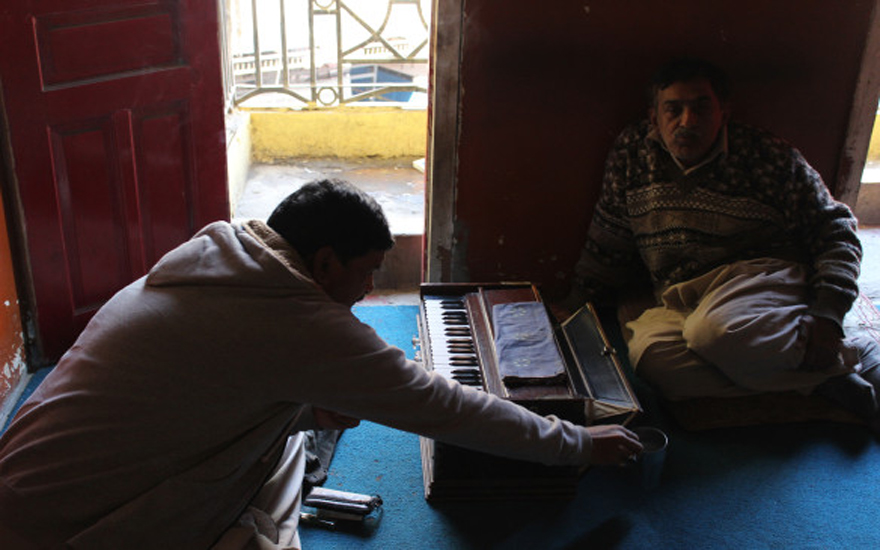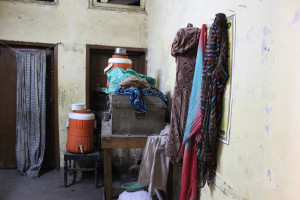Dancing to their Own Tune
The dense fog parts to let in a few rays of sunlight to illuminate Lahore’s colourful old city quarter on a chilly February day. I am on a quest. I cross Yadgar Bridge into Heera Mandi in search of the city’s ‘Classical Dance Academy’.
Lining the streets, the centuries-old buildings with their imposing architecture and elaborate woodwork still leave visitors spell-bound. It is one pm. Lahoris are done with breakfast and some are already running to get their lunch. The old city streets are full of the customary hustle and bustle as everyone rushes about their business.
But not everyone. A guard dressed in his blue security uniform, lethargically holding a gun, yawns while facing the radiant sun now shining down outside a restaurant in food street. Here waiters have started setting tables for their customers.
The guard guides me towards ‘Gate Number 4′ of the food street which faces the entrance to the majestic Badshahi Mosque. As I continue searching for the dance academy, I imagine it as a palatial structure with mirrors lining the walls where numerous students are busy imbibing the classical arts. But the moment I identify the structure housing the academy, my imagination is rudely jolted.
This is no palace with mirrored walls. The unpleasant odour that permeates the shabby old building and the narrow staircase in the dim interior of the dwelling make it hard for me to ascend.
On the first floor, broken carts, chairs and tables fill a small room. A middle aged man of medium height clad in filthy clothes rushes out and glares at me interrogatively.
“Kis si milna hay app ko?” he inquires. “I am here to visit the classical dance academy. I want to see the dance masters.” He signals me to follow him.
On the second floor, two men, in their forties, both wearing faded grey jeans and black jackets are practising music on their harmonium and tabla.
After around 45 minutes, two girls maybe around sixteen, emerge from the stairs. They bow down and salute the masters. A few minutes later, another pair of girls and a boy in his late teens enter the room.

The chief ustad Munawar Ali Khan instructs them to get ready for the class and they start tying ghungrus onto their ankles. The master sings ‘Tha Thin Thak Tha Thin’ and students move to the rhythm. One step forward. Another backwards. One arm high in the air, the other behind the body.
“Classical dance is vanishing from Pakistan. When we learnt it, there was a passion and a lot of people were interested in this art. Now there are very few,” Khan explains to me as he takes a break from the class. ”Some girls and boys from very rich families or then girls from a very modest background are the only ones interested in this art now. The more affluent come because of their fascination with the art while the poor come to learn the skill to further their careers in theatre and movies.”
“As this art disappears from Pakistan, so does our respect. There is no longer any honour in classical dance, nor is there any money. But we are bound to perform our moral duty to transfer this art to the younger generation,” says Khan. He takes a deep sigh and pauses.
I engage a student in conversation, the girl who had arrived first for the class. ”We are cousins,” says Zeenat pointing towards the other girl Zareen. “We are learning this art to become dancers for parties, stage dramas and ultimately movies,” she reveals shyly. ”My mother and my aunt are both ordinary dancers and still live in our old residential area of Tibi gali. We want to aim higher, work in the movies and live in a posh area in better conditions,” explains Zeenat. ”Our dream is to become the most successful heroines of the Pakistani film industry,” adds Zareen.
 But for Sheena, an O level student from Lahore’s upmarket Model Town locality, classical dance is a fascination. ”I was so mesmerised seeing a girl dancing at a mehndi function that I decided to learn this art,” enthuses Sheena. ”But it’s hard for me to come here every day. I have to concentrate on my studies and can’t waste my time in traffic jams on the way to this academy. I would request ‘Master Ji’ for a class in my area or at my house.”
But for Sheena, an O level student from Lahore’s upmarket Model Town locality, classical dance is a fascination. ”I was so mesmerised seeing a girl dancing at a mehndi function that I decided to learn this art,” enthuses Sheena. ”But it’s hard for me to come here every day. I have to concentrate on my studies and can’t waste my time in traffic jams on the way to this academy. I would request ‘Master Ji’ for a class in my area or at my house.”
But for Master Munawar Ali Khan and his friend tabla maestro Zafar Dilawar, it’s a compulsion to keep this academy going in the ‘red-light’ area of Heera Mandi. ”It’s easy to work here because everybody knows us. In other areas people may create problems because of music and dancing and mixed classes for girls and boys.” ”Even here, policemen disturb us and question the late-evening classes. But because the head of the local police station knows us personally, so he provides help.”
As Khan speaks, a smart young boy Asif Kanwal continues to practise his steps. ”I want to become famous like Maharaj Ghulam Hussain Kathak and Naheed Siddiqui,” he tells me. ”It’s not an easy thing for a man to wear ghungrus and dance. People look down upon you but I am determined to achieve my goal whatever I have to go through.”
“It needs time, devotion and a commitment for life,” emphasises Khan.
Outside in the street, the sun is now sinking on the horizon. The fog may appear again tomorrow but will clear for the sun as the day progresses. Sadly, Master Munawar Ali Khan doesn’t know when the fog will lift over the arts in Pakistan.



